Succeed with your borders
• Create a scenery with pots
• Growing plants in unusual containers
• Make your potted plants more beautiful
• Choose the material of pots
• Look after your pots to make them last
• The right pot for the right plant
• Upright-growing plants in pot
• Growing a tree in a pot
• Hiding a cumbersome stump
• Hiding the compost heap
• Optimize Trees
• How to redesign a flowerbed ?
• Create a flowering border like a painter
• Harmonise foliage between them
• Succeed with your borders
• An attractive garden in winter
• Create a Mediterranean corner
• Create an exotic area
• Create a Japanese corner
• Create a green roof
• Create a rockery
• An Acer, for all gardens
The borders, it is the key detail that makes the garden. In small spaces as in large ones, the border emphasises flowering beds and plants. A space framed by a border gives the impression of finished work. A detail may be, but of real importance!
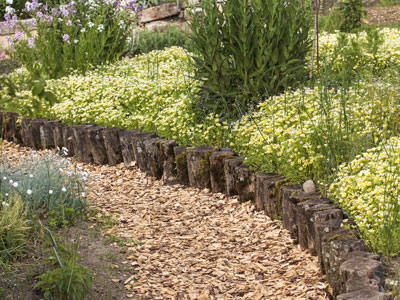
Three in one
The first benefit of a border is its useful side as it reduces the looking after of the space in between the lawn and the plants (or the walkways), where the grass is not reached by the cutting tools and makes its way in between plants. It is the way of landscaping this space and the type of material used which makes the style and the atmosphere of the border. In the old style, a small ditch was dug around the flowering beds and the grass that was growing into this small gap was sliced. But this method required a lot of work (the grass must be sliced two to three times a year) and some space is lost which is not ideal, especially in smaller gardens. It is best to trust the modern solutions.
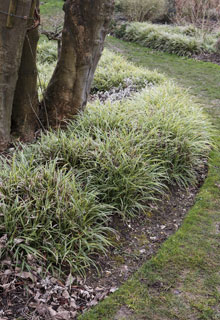
An old-style border.
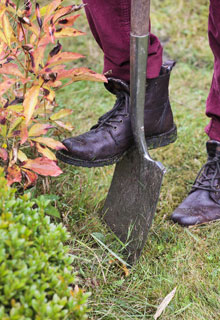
Without a physical border, you must regularly tidy up the lawn's border.
Along walkways, a border eases maintenance as you can for example use a thermal weeder without burning other plants. Finally, a border emphasises a flowering bed, often bringing to light the touch that makes it so picturesque, especially in the case of thematic flowering borders (Japanese-inspired, woodland's inspired, etc.).
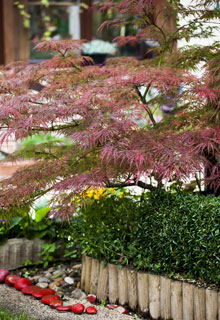
This border made of small logs put the finishing touches to this Japanese atmosphere.
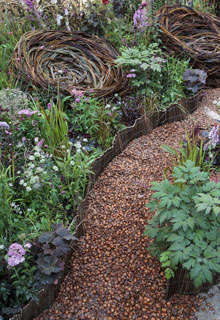
This well-defined path is easier to look after, thanks to the border.
Vertically
To carry out this transition between two surfaces, you can opt for vertical delimitation. This consists in creating a barrier, which goes up 5cm above the ground, between the two parts. It can be a plastic strip (rolled border), to bury and sit higher than the grass to ease the looking after with a lawn edger. The effect is at the same time discreet, clean and functional. Several models are available, from the highly visible one in small logs attached to wires, hard plastic or soft plastic models, etc. Buried planks, iron or stone elements are also suitable. You can even place a few logs for a woodland-effect. If you have lots of old tiles close to hand, you can also use them, burying them at least 15cm deep. The effect created is rather a 'bric-a-brac' one. You can also opt for a higher border, up to 50cm high. In that case it will be a decorative element in its own right.
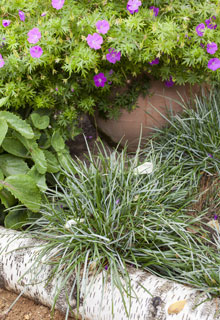
Birch logs are perfect in this woodland atmosphere.
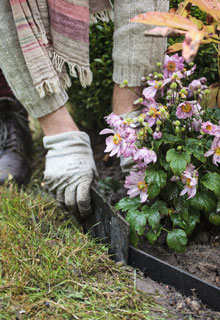
Old tiles can easily replace a birch-logs border.
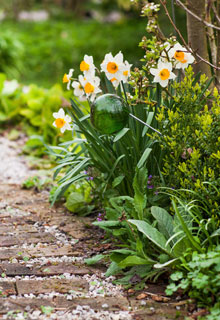
A border of buried tiles : maintenance free !
Horizontally
The other option to the border which is higher than the ground rests upon a large strip of 'non-green material's band, 15 to 20cm wide which runs along the flowering bed, as a frame would. The lawn won't grow up to it and if this band is not higher than the ground for more than a few centimetres, the lawnmower will be able to go over it and you won't even have a border to look after. It requires a bit of work to create this style of border, especially if the flowering bed has got curved lines but you will be happy in the long run.















































































































































































































































